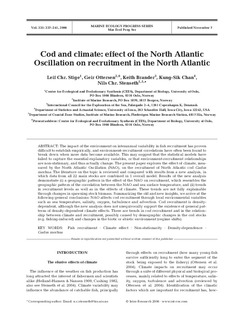| dc.description.abstract | The impact of the environment on interannual variability in fish recruitment has proven difficult to establish empirically, and environment-recruitment correlations have often been found to break down when more data become available. This may suggest that the statistical models have failed to capture the essential explanatory variables, or that environment-recruitment relationships are non-stationary, and thus actually change. The present paper explores the effect of climate, measured by the North Atlantic Oscillation (NAO), on the recruitment of North Atlantic cod Gadus morhua. The literature on the topic is reviewed and compared with results from a new analysis, in which data from all 22 main stocks are combined in 1 overall model. Results of the new analysis demonstrate (i) a geographic pattern in the effect of the NAO on recruitment, which resembles the geographic pattern of the correlation between the NAO and sea surface temperature, and (ii) trends in recruitment levels as well as in the effects of climate. These trends are not fully explainable through changes in spawning stock biomass. Summarizing the old and new insights, we arrive at the following general conclusions: NAO affects cod recruitment through local environmental variables such as sea temperature, salinity, oxygen, turbulence and advection. Cod recruitment is density-dependent, although the new analysis does not unequivocally support the existence of general patterns of density-dependent climate effects. There are trends in cod recruitment and in the relationship between climate and recruitment, possibly caused by demographic changes in the cod stocks (e.g. fishing-induced) and changes in the biotic or abiotic environment (regime shifts). | no_NO |

